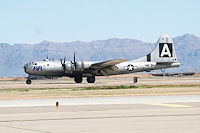 The US Strategic Bombing Campaign on Japan, Part 3
The US Strategic Bombing Campaign on Japan, Part 3
By John Dudek @ The Wargamer
As soon as Colonel Paul Tibbets felt his B-29 bomber the “Enola Gay” lurch upwards following the release of the 9,700 lb. atomic bomb “Little Boy” from its bomb bay, he and his co-pilot advanced or “firewalled” the engine throttles to maximum over boost as he put the plane into a shallow dive to gain as much speed as possible and put as many miles between his fleeing bomber and the nuclear bomb currently hurtling towards earth. He had two minutes before the bomb was scheduled to detonate in an air burst 2,000 feet above the city. He ordered his crew to put on their welders goggles over their eyes to shield them from the bomb’s expected blinding flash. Concussion from the bomb’s detonation rattled and shook the bomber as one crewman exclaimed “My God!” over the interphone as to what he witnessed below. A massive mushroom shaped cloud of many colors boiled and arose thousands of feet above the now brightly blazing city. A Japanese fighter pilot flying through the same cloud rolled back his canopy and stretched his hand outside the cockpit to the colorful smoke all around his plane. In doing so, he unknowingly signed his own death warrant and soon died from radiation poisoning in the coming days. The bomb killed 78,000 people although many thousands more would die from its after effects in the weeks, months and years afterwards. In addition, the bomb destroyed almost 5 square miles of the city. The Enola Gay and its five accompanying weather spotter bombers returned to the Marianas without incident. Their 509th Composite Group had dropped the very first atomic bomb in wartime history. Unfortunately, the Japanese military government remained completely unmoved in their fervent Bushido code desire to continue their suicidal war to its bitter, bloody end against the Allies.

